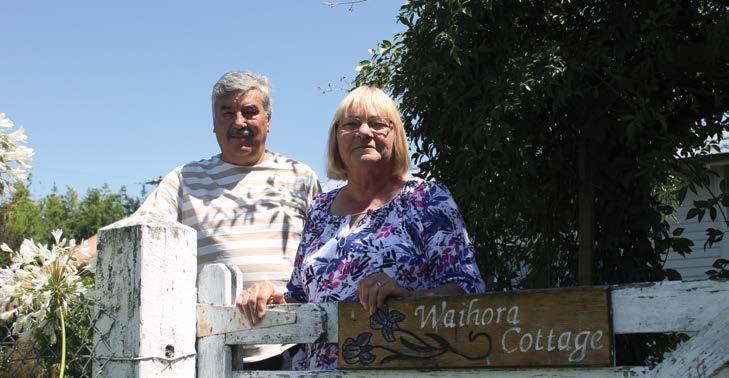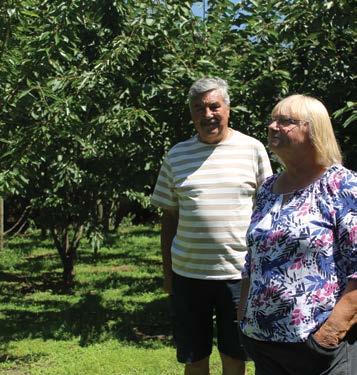
8 minute read
The world is changing, Gisborne growers warn
The climate having played havoc with their cherry orchard, Adriana and Michael Mather plan to stay at their rural idyll in Te Karaka but are in talks to hand their plantings over to a younger couple who, they say, would have more energy to make it work
A pair of Gisborne growers knew they were taking a risk planting cherries in a temperate area but say the pace of climate change took them by surprise … and took their orchard out of action.
By Kristine Walsh
Long-time residents of New Zealand, Adriana (originally from Scotland) and Michael (England) Mather met on a blind date in 2001, and with their respective adult children well established, decided the new year signified time for a new life – together.
The couple lived in Gisborne for a while but by 2004 had bought in Te Karaka – just 25 minutes inland from Gisborne – nearly half a hectare of land complete with a dilapidated cottage that was formerly home to the resident District Nurse.
For the next few years they continued to work in Gisborne while renovating the cottage and plotting what they would do with their little patch of paradise. “It was just a bare paddock that had been leased for grazing but I could see there was potential for putting on something to create an income,” Adriana says. “So we took a couple of years to think it over, to work out what we thought would be a good crop.” The soil was good, having formerly been used both to graze young cattle and to grow kumara. “And the weather at that time told us there was enough cold during winter to make cherries viable, so we decided to go with that.”
GROWING CHERRIES
Production volume varies from 8 to 10 tonnes per hectare for light cropping varieties, to 14 to 16 tonnes per hectare for heavy cropping varieties.
The ideal climate for growing cherries has more than 800 hours of temperatures between 2°C and 12°C over the winter dormant period, providing the chill that stimulates even blossoming once temperatures rise. Summerfruit NZ says cherries require deep, well drained soils – generally on flat land – good protection from winds and plenty of sun in summer.
25ha
According to AgFirst, 25 hectares are required for commercial scale but smaller areas (7–10ha) can be profitable if they are efficiently run by an owner-operator. Low rainfall and humidity over the blossom period (mid-September to mid-October) is also required, along with low rainfall/humidity from two to three weeks before harvest to completion of harvest. Northern regions like Hawke's Bay do not experience this winter chill, so growers use a dormancy breaking chemical that causes the tree to blossom.

The price of entry to the industry can be high: with costs including irrigation and trellis, it can reach $150,000 to $200,000 per hectare.
$15
Returns on the local market also vary, with kilos fetching around $10 to $15 (before packing, packaging and freight are deducted) pre-Christmas, and about one-third of that after Christmas. AgFirst says cherry trees deliver their first light harvest after three to four years, increasing each year until maturity at six to eight years.
Cherries are known to be a challenging crop, with a relatively high risk of failure and labour-heavy harvests.
80%
Around 80% of the national crop is exported, with returns varying. Planting density can range from 800 to 1,600 trees per hectare.
90%
Around 90% of the more than 720 hectares of cherries grown in New Zealand are in Central Otago.

They weren't alone in their thinking: at the time Adriana, an accounts administrator, was working for a local orchardist who had the same idea.
“So in 2007 he ordered 1,000 cherry trees, we ordered 90, and we planted them on our properties. He was very generous with his time and advice, so we're sad that it didn't work out for him either.”
Rewarding the couple's optimism, things started well at Waihora Cherries with their plantings of Sweetheart, Roseanne, Earlise and Santina varieties. They added 40 more trees which, with the existing crop, they protected by planting a shelterbelt for relief from the “horrendous” westerly winds. “We were only a small operation anticipating two to three kilograms from each of our 130 trees, with the season lasting from late November until late December,” Adriana says. “And that's what we got. We could have sold a lot more – especially through the local Farmer’s Market – but that was enough for us to manage.” Then things started to go wrong – first with an annual influx of blackbirds, which they combated with bird netting; then with brown rot, which meant they had to change their spray-free ideals. The kicker, though, was the change in the local climate and how fast that occurred.
Te Karaka is known for its microclimates – in places it is often much hotter and drought-prone in summer than nearby Gisborne, and much colder in winter with periods of very heavy rain. When the Mathers first bought their property some 16 years ago they kept a weather diary that showed their patch got cool night-time temperatures plus a couple of frosts a week throughout winter.
“But in the winter of 2020 we only got four frosts for the entire season and night temperatures rose by at least a couple of degrees, plus both the rainfall and the equinox winds come later and are more extreme,” Adriana says. “That makes all the difference between okay cherrygrowing conditions and really bad ones and it all happened within a very short period of time.”
Online Orchard Irrigation Supplies
Call our experts 0800 130 905
www.irrigationexpress.co.nz


The care lavished by Adriana and Michael Mather has made for healthy cherry trees, but the fruit itself has suffered from increasingly fewer frosts and more dramatic – and untimely – rain events
The upshot is that if they were to continue to run their orchard, it would be more capital and labour-intensive requiring rain covers and a diligent regime to deal with fungal and pest damage, she says. “Even over in Hawke's Bay, which gets colder than here, the big orchards are covered with netting and many with rain covers as well.”
The Mathers have not been alone in their experience. As the fruit was ripening late last year an orchard of 300 cherry trees at Patutahi – around 15 kilometres from Gisborne – suffered heavy rain that cost the growers twothirds of their anticipated crop. Meanwhile, with both Adriana and Michael Mather both well into retirement age, they will stay at their rural idyll in Te Karaka but are in talks to hand their plantings over to a younger couple who, they say, would have more energy to make it work.
The Mathers are philosophical about their experience, but while noting there are different ideas about the speed and causes of climate change, hope that others can learn from it. “When we started we thought the cherries would work but had no idea of the pace of climate change, and the impact that would have,” Adriana says. “What we're saying is that if the climate is not quite right for your crop, that could only get worse, and much faster than you think.” While a couple of Gisborne growers have concluded that “perhaps cherries should stay down south”, even southern growers have not had an easy time of it this season.
In normal conditions, Central Otago produces about 90% of New Zealand’s cherry exports, with a value of $84.1 million in 2017–18 and $66.2 million the following season. However, the region's growers lost up to half their anticipated crop in 2019–20 after poor weather during the pollination period in spring and a cool, wet start to summer.
And this 2020–21 season has been no better: two days of torrential rain that started on New Year’s Day left split cherries rotting in the orchards, with growers reporting losses of up to 50% of their crops … a loss of $50 million in export revenue. Even worse, according to Summerfruit NZ, flooding damage to trees – particularly on orchards around Earnscleugh – could affect next season’s crop. By the second week of January growers were working to harvest what was left of their crops and with good weather predicted there was still work for pickers and packers, said Summerfruit NZ chief executive Richard Palmer.
However, the persistent and heavy nature of the rain had not been experienced in 40 years and despite most growers being natural optimists, watching their year’s work wiped out was a “devastating” blow. “It is incredibly sad to see growers lose so much of their crop in this way,’ Richard Palmer said. “We are working hard to assess what the impact will be on both orchards and the workers, and are looking at how we can keep people in work for the summerfruit season followed by harvests of apples, grapes and pears.”











